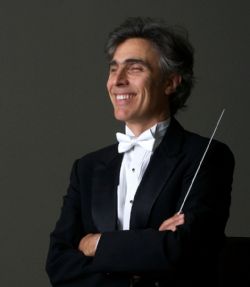|
Symphony
SRS SEASON ENDS WITH RESOUNDING TA-TA-TA-BANG
by Terry McNeill
Sunday, June 1, 2025
Symphony
YOUTHFUL VIRTUOSITY ON DISPLAY AT USO'S MAY CONCERTS
by Peter Lert
Saturday, May 17, 2025
Symphony
MYSTICAL PLANETS AND LIVELY GERSHWIN ORTIZ AT FINAL SRS CONCERT
by Peter Lert
Sunday, May 4, 2025
Symphony
VSO'S CONCERT MUSIC OF TIME, MUSIC OF PLACE
by Peter Lert
Sunday, April 27, 2025
Choral and Vocal
VOCAL ELEGANCE AND FIRE AT THE 222'S RECITAL APRIL 26
by Pamela Hicks Gailey
Saturday, April 26, 2025
CANTIAMO SONOMA SINGS AN INSPIRED GOOD FRIDAY MOZART REQUIEM CONCERT
by Pamela Hicks Gailey
Friday, April 18, 2025
DRAMATIC SHOSTAKOVICH SYMPHONY CLOSES PHILHARMONIC'S 25TH SEASON
by Terry McNeill
Sunday, April 13, 2025
LARGE COLLEGE OF MARIN AUDIENCE GREETS STOPHER ARTISTRY
by Terry McNeill
Saturday, April 5, 2025
Chamber
FRISSON DELIVERS SHIVERS OF DELIGHT
by Abby Wasserman
Sunday, March 30, 2025
OLD AND MOSTLY NEW IN SRS MARCH CONCERT IN WEILL
by Peter Lert
Saturday, March 22, 2025
|
 |
 SRS Guest conductor David Lockington |
WELL WITHIN THE BOX
by Steve Osborn
Saturday, January 24, 2009
Before the Santa Rosa Symphony began its concert Saturday, the public-address announcer said there would be a short presentation on behalf of the Youth Orchestra. A tall, red-headed young woman then rose from the concertmaster’s chair and offered an exquisite reading of a brief, unidentified Romantic violin solo. After the applause, the Youth Orchestra manager strode to the stage, identified the soloist as the orchestra’s concertmistress, and informed the audience that the ensemble was only $10,000 short of the $289,000 needed to pay for a concert tour of Europe this summer.
It was heartening to learn that the Youth Orchestra is still thriving despite the economic downturn, and to hear the quality of one of its musicians. Less heartening was the apparent effect of the downturn on the Symphony itself. There were more than a few empty seats, including most of those in my balcony row.
Perhaps another reason for the less-than-full house was the absence of Maestro Bruno Ferrandis, who has developed an avid following in his few short years in Santa Rosa. His replacement, David Lockington, conductor of the Modesto Symphony, had large shoes to fill, along with some relatively unfamiliar repertoire — a double whammy.
Lockington is an unassuming, workmanlike conductor, as became immediately evident in the opening work, Carnaval for Orchestra, by the contemporary Puerto Rican composer Roberto Sierra. This work, premiered last year as part of the Magnum Opus project, could have been written many decades before. Taking an obvious cue from Robert Schumann, the five movements depict, in the composer’s own words, “five creatures of imagination,” namely gargoyles, sphinxes, unicorns, dragons, and the phoenix.
Using almost every instrument at its disposal, Sierra’s score evokes this bestiary mainly through orchestral color, with a plethora of muted trumpets, shimmering strings, eerie woodwinds, and all manner of percussion. Lockington kept all these elements under control with an unflagging beat and precise cues. He did not, however, bring much forward motion to the work.
That lack of motion is as much Sierra’s fault as Lockington’s. Like many composers of his ilk, Sierra seems content to paint a sonic portrait of a given image, but without investing that image with a temporal or narrative aspect. Through the density and variety of its sound, Carnaval engaged the senses, yet the mind wanted more.
Next up was another programmatic work, Bernstein’s Halil, for flute and orchestra, featuring the guest artist, Carol Wincenc. Modern flute concertos are a fairly rare breed, and this one almost doesn’t qualify as a solo concerto, given the prominent role played by an offstage alto flute and piccolo.
Bernstein wrote Halil to commemorate a young Israeli flutist killed during the 1973 Arab–Israeli war. As befits its subject, the piece is by turns elegiac and percussive, with a virtual army of snare drums replicating the drumbeat of war. Wincenc invested the score with a certain degree of emotion, yet her tone was a bit thin, and she was often upstaged by the offstage players. As if to atone for this shortcoming, she quickly launched into an encore, the Fantaisie by Fauré. This was short and sweet and allowed her to display some virtuosic chops.
After a steady diet of program music, it was a relief to hear the more abstract strains of Copland’s Third Symphony following intermission. This classically formal work contains some of Copland’s best music, from the open harmonies at the beginning to the well-known fanfare at the end. When performed with vigor and insight, it can be inspiring.
Unfortunately, Lockington’s natural restraint kept the symphony well within the box. Unlike Ferrandis, Lockington hardly moves when he conducts, and the players likewise kept to their notes without displaying much emotion. Too much of the playing was at the same level, a kind of tepid mezzoforte, without the full dynamic range that Copland’s music requires.
The strings were solid throughout, though the brass and woodwinds were occasionally ragged. Tempi were often on the slow side, particularly in the Andantino third movement, which often seemed on the verge of dissolving. Fortunately, the pace quickened in the last movement, and the brass and woodwinds offered several convincing iterations of the famous Fanfare for the Common Man. By the end, the glory of the writing overcame most of the performance’s shortcomings.
All in all, it wasn’t a great concert, but it offered some solid music-making and a glimpse of unfamiliar repertoire. More important, the donation table for the Youth Orchestra was mobbed at intermission, and the proffered hats were overflowing.
[This article first appeared in San Francisco Classical Voice (www.sfcv.org), and is used by permission.]
|
